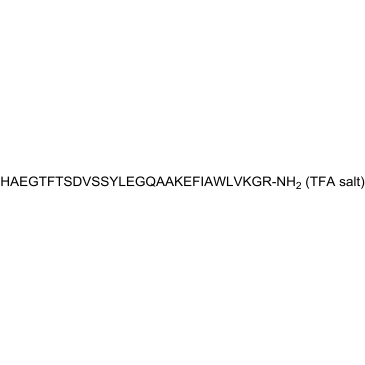GLP-1(7-36), amide TFA (Synonyms: Glucagon-like peptide-1 (GLP-1)(7-36), amide TFA; Human GLP-1 (7-36), amide TFA) |
| Catalog No.GC60876 |
GLP-1(7-36), amida TFA es una importante hormona intestinal que estimula la secreciÓn de insulina inducida por glucosa de las células β.
Products are for research use only. Not for human use. We do not sell to patients.

Sample solution is provided at 25 µL, 10mM.
GLP-1(7-36), amide TFA is a major intestinal hormone that stimulates glucose-induced insulin secretion from β cells[1].
Cells treated with phorbol 12-myristate 13-acetate for 2 h has significantly higher active GLP-1(7-36) Acetate (Human GLP-1-(7-36)-amide Acetate) concentrations in the media than those in the control. The glucose treatment also increases active GLP-1 secretion from cells in dose-dependent manner. Palmitic, oleic, linoleic or linolenic acid dose-dependently stimulated active GLP-1 secretion from cells. Active GLP-1 secretion is significantly greater with unsaturated fatty acids such as oleic, linoleic and linolenic acids than with palmitic acid. The treatment of NCI-H716 cells with CPE dose-dependently increases active GLP-1 concentrations in the media. A 37% increase is observed in active GLP-1 secretion from these cells at a concentration of 0.1 % CPE[1].
Gastric administration of glucose increases active GLP-1(7-36) amide levels in the portal blood after 10 min, followed by a marked decrease at 30 min. The gastric administration of TO also increases active GLP-1 levels after 10 min, and followed by a decrease to basal levels at 60 min. Individually, glucose and TO increase the secretion of GLP-1 in a dose-dependent manner. Furthermore, the co-administration of glucose and TO additively increase peak GLP-1 levels. CPE-administered mice have higher active GLP-1 levels in the portal blood at 10 and 30 min than those in the control mice. When glucose is administered with CPE, active GLP-1 and insulin levels in the portal blood are slightly higher in CPE-administered mice than in the control mice. High-fat diet-fed C57BL/6J mice develop hyperglycaemia and impair glucose tolerance[1].
[1]. Fujii Y et al. Ingestion of coffee polyphenols increases postprandial release of the active glucagon-like peptide-1(GLP-1(7-36)) amide in C57BL/6J mice. J Nutr Sci. 2015 Mar 3;4:e9.
Average Rating: 5 (Based on Reviews and 30 reference(s) in Google Scholar.)
GLPBIO products are for RESEARCH USE ONLY. Please make sure your review or question is research based.
Required fields are marked with *




















